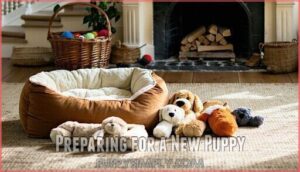This site is supported by our readers. We may earn a commission, at no cost to you, if you purchase through links.
 Before you bring home that adorable ball of fur, you’ll need to examine several key factors.
Before you bring home that adorable ball of fur, you’ll need to examine several key factors.
Puppies require significant financial investment – think vet bills, quality food, and supplies that can easily run $1,000+ in the first year.
You’re also looking at a 10-15 year commitment that demands daily training, exercise, and attention.
Reflect on your living space, work schedule, and family dynamics.
Different breeds have vastly different energy levels and temperaments, so research thoroughly.
Puppy-proofing your home is essential, as is establishing routines for feeding, potty breaks, and socialization.
Understanding these realities upfront helps confirm you’re truly ready for the rewarding journey ahead, which includes making a significant financial investment and considering your living space.
Table Of Contents
- Key Takeaways
- Is Getting a Puppy Right for Me?
- What Are The Costs of Owning a Puppy?
- What Are The Time Commitments for a Puppy?
- What Space Restrictions Should I Consider?
- What Restrictions May Apply?
- What Cleanliness Measures Are Required?
- What Are The Temperaments of Different Breeds?
- What Lifestyle Adjustments Are Necessary?
- Preparing for a New Puppy
- Frequently Asked Questions (FAQs)
- What should you know before getting a dog?
- What should I know before a puppy comes home?
- How do I choose a puppy?
- How do I know if my puppy is healthy?
- How do you prepare a puppy for a new puppy?
- Are You Ready to get a dog?
- What should I know before I get a puppy?
- What vaccinations do puppies need?
- How often should puppies be groomed?
- What type of food should I feed my puppy?
- Conclusion
Key Takeaways
- You’ll need significant financial resources – Expect to spend $1,000+ in the first year alone on vet bills, quality food, and essential supplies, with ongoing annual costs ranging from $1,500 to $9,900, depending on your puppy’s size and needs.
- You’re committing to a 10-15 year responsibility – Puppies require daily training, exercise, and attention with a structured routine that includes potty breaks every two hours and 1-2 hours of focused interaction daily.
- Your lifestyle will change dramatically – You’ll need to cancel spontaneous trips, adjust your work schedule, modify your home environment, and accept less flexibility in your daily routine for months while your puppy adapts.
- Proper preparation prevents problems – You must puppy-proof your home, research breed-specific temperaments and energy levels, gather essential supplies before arrival, and establish consistent training routines from day one.
Is Getting a Puppy Right for Me?
Getting a puppy is exciting, but it’s a big decision.
Ask yourself: Is your household ready for the commitment level puppy ownership demands? Puppies need time, patience, and resources.
From puppy care and training to managing puppy expenses, it’s not a small task. Think about family impact—are kids prepared?
Will lifestyle changes, like less travel, fit in? If it feels overwhelming, consider alternative options like adopting an adult dog.
Puppies bring joy, but they’re also a full-time responsibility.
What Are The Costs of Owning a Puppy?
Owning a puppy isn’t just cuddles and tail wags—it comes with a price tag.
Initial costs, like adoption or purchase fees, vaccinations, spay/neuter surgery, and puppy supplies, can range from $250 to $4,000 or more.
Recurring expenses add up quickly, including food, grooming, puppy vet visits, and puppy insurance, costing $1,500 to $9,900 annually.
Breed specifics matter too; small breeds may cost less in food but require grooming, while larger breeds incur higher feeding costs.
Understanding optimal puppy nutrition is key to budgeting effectively.
Unexpected costs, like emergency vet bills or replacing chewed-up shoes, can sneak up on you.
Consider DIY alternatives for toys or bedding to save money.
A detailed puppy expenses breakdown helps you plan better and avoid surprises while giving your furry friend the care they deserve.
What Are The Time Commitments for a Puppy?
Time is a big investment when you bring a puppy home. Puppies thrive on a structured daily routine, so expect your schedule to revolve around potty training, crate training, and regular feeding times.
Young pups need potty breaks every two hours, which means constant supervision. Socialization time is also key—introducing your puppy to new people, pets, and environments helps them grow into confident dogs.
Training hours are another must. Teaching basic commands, leash manners, and boundaries takes patience and consistency. Puppies also need exercise to burn off energy, but not too much to avoid overexertion.
Between playtime, training, and cuddles, you’ll spend 1-2 hours daily giving them attention. Remember, a well-adjusted puppy depends on your commitment to their schedule. Many owners find success using proper crate products during this phase.
What Space Restrictions Should I Consider?
If you’re thinking about getting a puppy, it’s important to think about your home’s space. Puppies need room to play, rest, and stay safe.
If you live in an apartment, focus on providing enough indoor space for supervised play and make sure the building allows pets. A small or medium breed may fit better in tighter spaces, but remember, energy levels vary by breed.
For homes with yards, make sure the area is fenced and free of puppy hazards like sharp tools or toxic plants. Dedicated spaces like crates or pens can keep your pup safe when unsupervised.
Whether it’s your living room or an outdoor dog run, puppyproofing is key. Remove chewable items, secure electrical cords, and keep cleaning supplies inaccessible.
Planning for puppy safety makes certain your furry friend thrives in your environment. Consider using a safe indoor enclosure for added security. This will help ensure your home is pet-friendly and safe for your new puppy.
What Restrictions May Apply?
Before jumping into puppy adoption, check for local breed restrictions, rental restrictions, or HOA rules that could cramp your plans.
Some places may ban certain breeds like Pit Bulls or limit dog sizes entirely. Your landlord’s pet policy and family objections should also factor into your puppy preparation checklist.
Travel limitations, like vaccination or age requirements, can complicate future plans.
Research thoroughly, puppy-proof your home, and prepare for puppy costs to avoid surprises. A little planning makes for a smoother start!
What Cleanliness Measures Are Required?
Bringing a puppy home means adapting your cleanliness routine to keep your space fresh and safe.
Their curious nature often leads to messes, so it’s important to stay prepared with proper hygiene habits and tools.
Here are essential tips for maintaining a clean home with a puppy:
- Accident cleanup: Use enzyme-based cleaners to remove stains and odors from puppy accidents effectively.
- Odor control: Wash bedding and toys regularly, plus vacuum and sweep to handle shedding and dirt.
- Sanitation supplies: Keep pet-safe cleaning products on hand for quick spot cleaning.
- Parasite prevention: Regularly check your puppy for fleas and ticks, especially in warmer months.
- Puppy proofing home: Secure toxic chemicals, cords, and small items to avoid accidents.
Be consistent with supervision and grooming routines for easier housetraining.
Clean surroundings support a happy, healthy pup—and a stress-free owner!
What Are The Temperaments of Different Breeds?
Different puppy breeds come with unique personality traits that can shape your everyday life.
Some breeds, like Labrador Retrievers, are warm and outgoing, making them perfect for families. Beagles charm with their merry personalities and thrive on companionship, while French Bulldogs bring affection and adaptability into any home.
On the other hand, smaller breeds like Alaskan Klee Kai or Affenpinscher are curious and energetic, great for active owners. Breed-specific needs, such as exercise or socialization strategies, play a huge role in puppy temperament.
Here’s a quick comparison to help you match a breed with your family:
| Breed | Personality Traits | Exercise Needs | Family Compatibility |
|---|---|---|---|
| Labrador Retriever | Friendly, outgoing | High | Ideal for families |
| Beagle | Gentle, social | Moderate | Kid-friendly |
| French Bulldog | Affectionate, adaptable | Low | Apartment-friendly |
| Affenpinscher | Loyal, amusing | Moderate | Loves attention |
Pick a puppy breed that clicks with your lifestyle!
What Lifestyle Adjustments Are Necessary?
After considering breed temperaments, you’ll need to make significant changes to accommodate your new companion.
A puppy routine completely reshapes your daily life – from early morning potty breaks to evening training sessions.
Your social life, travel plans, and sleep schedule will revolve around puppy schedules for months.
Here are the major puppy lifestyle considerations you’ll face:
- Cancel spontaneous weekend trips – puppies can’t be left alone for extended periods
- Adjust your home environment by removing hazards and creating puppy-safe spaces
- Modify personal habits like leaving shoes around or eating on low tables
- Accept puppy responsibility means less flexibility in your daily schedule
- Prepare for puppy changes affecting work commitments and after-hours activities
Preparing for a New Puppy
Once you’ve decided a puppy fits your lifestyle, you’ll need to tackle the practical steps that facilitate a smooth shift for both you and your new companion.
From puppy-proofing your home to gathering essential supplies, proper preparation prevents common mistakes and sets the foundation for successful training and bonding.
Create a Checklist
Creating a thorough puppy checklist before your furry friend arrives sets you up for success.
This Essential Supplies list guarantees you’re ready for those first vital weeks when everything feels new and overwhelming.
Your new puppy checklist should cover immediate needs and long-term care.
Start with the basics: food and water bowls, a sturdy leash, and an adjustable collar that’ll grow with your pup.
Don’t forget training pads for those inevitable accidents during house training.
Essential puppy supplies include:
- Cozy crate with soft bedding – your pup’s safe haven for rest and training
- Variety of age-appropriate toys – squeaky, plush, and chew toys for entertainment
- High-quality puppy food and healthy treats – fuel for growing bodies and training rewards
Your puppy preparation should also include a Vet Checklist for scheduling that first health appointment within days of arrival.
Having these Training Resources and Home Preparation items ready means less stress for everyone when your new family member arrives.
Bringing Your New Puppy Home
Your puppy’s first night sets the tone for everything ahead. Create safe spaces by puppy proofing rooms and removing hazards like electrical cords or small objects.
Set up their designated living area with a comfortable bed and crate. During this vital settling in period, introduce family members gradually and supervise all interactions.
Focus on initial training by establishing house rules and boundaries. Remember your puppy preparation and checklist? Now’s when those puppy supplies become lifesavers.
Take settling in slowly—bonding tips include patience and gentle guidance.
Feeding Your Puppy
Once you’ve created a safe space for your new furry friend, it’s time to focus on their nutritional needs.
Your puppy’s healthy diet forms the foundation for proper growth and development. Here’s your puppy feeding guide:
- Choose age-appropriate puppy food – Select high-quality puppy food types designed for your pup’s size and breed, avoiding artificial additives that could trigger food allergies.
- Establish a consistent feeding schedule – Feed your puppy 2-3 times daily at the same times to create routine and aid digestion.
- Practice proper portion control – Follow manufacturer guidelines and adjust based on your puppy’s activity level and growth rate.
- Monitor hydration needs – Keep fresh water available at all times, as puppies need constant access to stay properly hydrated.
Consult your breeder or veterinarian about specific puppy nutrition requirements.
Stock up on healthy treats for training sessions, but remember that puppies eat frequently and grow quickly, so you’ll need a good supply of quality food.
Exercising Your Puppy
Your puppy’s exercise needs differ greatly from adult dogs.
Young pups require gentle activities that protect developing joints while managing their sky-high energy levels.
A good rule of thumb: five minutes of exercise per month of age, twice daily.
| Age Range | Exercise Duration | Best Activities | Frequency |
|---|---|---|---|
| 8-12 weeks | 10-15 minutes | Indoor play, short walks | 2-3 times daily |
| 3-4 months | 15-20 minutes | Yard exploration, puppy classes | 2-3 times daily |
| 4-6 months | 20-30 minutes | Longer walks, fetch games | 2 times daily |
| 6+ months | 30+ minutes | Hiking, running (gradually) | 1-2 times daily |
Mental stimulation matters as much as physical exercise.
Puzzle toys and training sessions tire puppies faster than walks alone.
Different breeds have varying puppy energy levels—border collies need more activity than bulldogs.
Watch for panting or excessive tiredness, signaling it’s rest time.
Training Your Puppy
While exercise builds your puppy’s body, training shapes their mind and behavior for life.
Start basic commands like "sit" and "recall" at home before venturing into more distracting environments.
Crate training creates independence and supports potty training by establishing a routine.
Your puppy can’t hold it for long, so consistency is key for successful housetraining.
Socialization tips include exposing your pup to different people, sounds, and environments during their critical development window.
Consider obedience classes for structured learning and social interaction with other dogs.
Chew toy selection matters—provide appropriate outlets for teething to prevent furniture destruction.
Training treats work wonders for reinforcing good behavior around the house.
Talk to family members about consistent rules and boundaries everyone should follow.
Remember, puppy training is an ongoing process that requires patience.
With dedicated practice, you’ll see remarkable progress in your pup’s obedience and confidence.
Frequently Asked Questions (FAQs)
What should you know before getting a dog?
Look before you leap" applies perfectly here.
You’ll need time, patience, and commitment for training, feeding, and veterinary care.
Consider your lifestyle, living space, and financial readiness before bringing home your new companion.
What should I know before a puppy comes home?
Puppy-proof your home by securing hazardous items, setting up a quiet space with bedding, gathering essential supplies like food bowls and toys, and scheduling a veterinary appointment within days.
How do I choose a puppy?
Finding your perfect furry companion is like discovering a missing puzzle piece.
Trust your instincts when meeting puppies—the right one often chooses you.
Consider your lifestyle, space, and energy levels to guarantee a harmonious match.
How do I know if my puppy is healthy?
Watch for bright eyes, clean ears, and a wet nose.
Your pup should be playful, alert, and eating well.
Schedule a vet visit within days to confirm vaccinations are current and overall health looks good.
How do you prepare a puppy for a new puppy?
Don’t put all your eggs in one basket—gradually introduce your current dog to the new puppy’s scent first.
Create separate spaces, supervise initial meetings closely, and maintain your older dog‘s routine to reduce stress, following the concept of not putting all your eggs in one basket.
Are You Ready to get a dog?
Consider your lifestyle, living space, and time commitment carefully. Dogs need daily exercise, training, and companionship for 10-15 years. You’ll handle accidents, chewing, and vet bills. Are you truly prepared?
What should I know before I get a puppy?
A stitch in time saves nine" applies perfectly here.
You’ll need time for housetraining, socialization, and constant supervision.
Puppies chew everything, need frequent potty breaks, and require years of commitment—they’re adorable but demanding companions.
What vaccinations do puppies need?
Your puppy needs core vaccines like DHPP (distemper, hepatitis, parvovirus, parainfluenza) and rabies, plus optional ones like Lyme disease.
Start at 6-8 weeks with boosters every 3-4 weeks until 16 weeks old.
How often should puppies be groomed?
Ironically, that "low-maintenance" pup needs weekly brushing and monthly nail trims.
You’ll bathe them every 4-6 weeks unless they’ve rolled in mud.
Professional grooming every 6-8 weeks keeps coats healthy and manageable.
What type of food should I feed my puppy?
Feed your puppy high-quality food specifically formulated for their breed size and age.
Choose brands without artificial additives.
Stainless steel bowls work best, and you’ll need to adjust portions as they grow rapidly.
Conclusion
Getting a puppy means embracing joy, accepting responsibility, and committing to years of companionship.
You’ve learned about costs, time demands, and preparation requirements. You’ve explored breed temperaments, space needs, and lifestyle changes.
Now you’re equipped with essential knowledge to make an informed decision. Remember, understanding all the things to know before getting a puppy guarantees you’re ready for this life-changing adventure.
Take time to evaluate your readiness, then welcome your new furry family member home, and get ready for a new experience that brings companionship.
- http://akc.org/expert-advice/training/how-do-you-raise-a-confident-puppy/
- https://www.ihomepet.com/are-yorkies-easy-to-train/
- https://www.akc.org/expert-advice/health/how-to-find-best-veterinarian/
- https://www.humanesociety.org/resources/why-you-should-spayneuter-your-pet
- https://www.pawleaks.com/all-17-questions-you-need-to-ask-your-potential-breeder/












